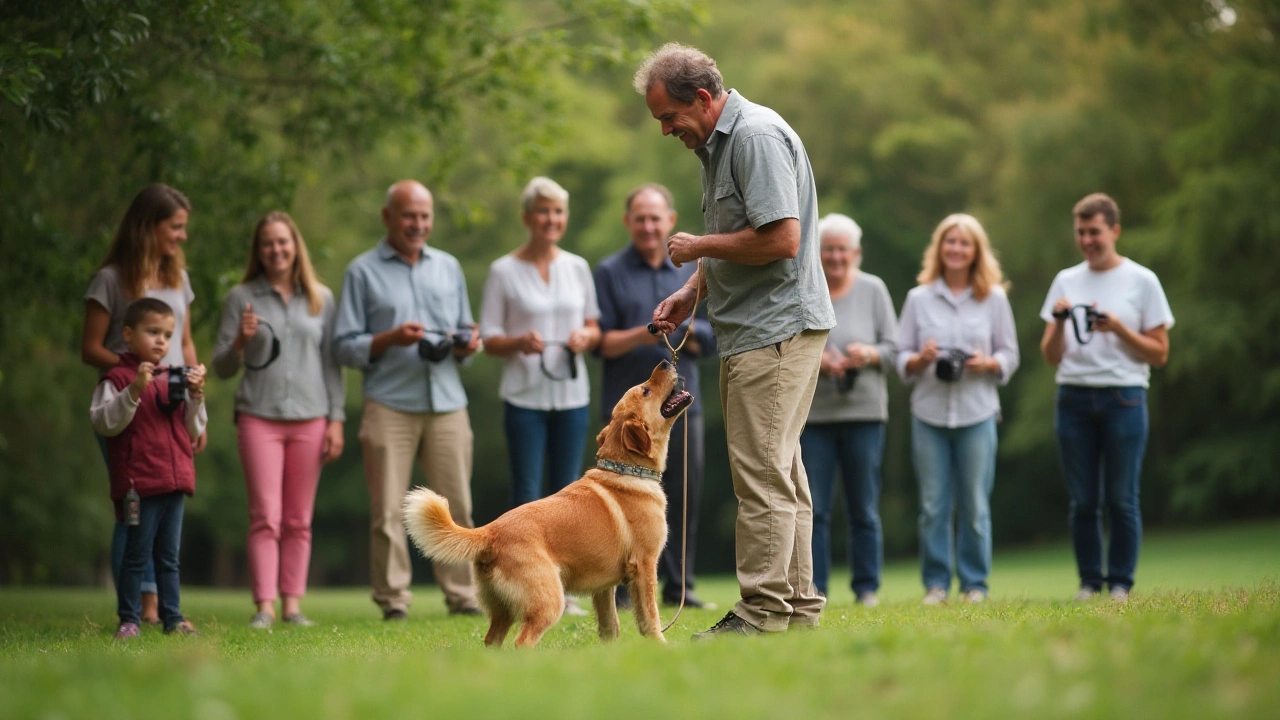In the world of pet care and training, prong collars often stir up quite a debate. For many dog owners, the decision of whether or not to use these collars comes with a bundle of questions and concerns.
Veterinarians play a crucial role in guiding pet parents, as their insights into animal health and behavior offer a fountain of wisdom. While some vets believe prong collars can be used effectively when in the hands of a knowledgeable trainer, others point to an array of potential risks.
This article delves into these viewpoints, aiming to shed light on what these collars are, their intended purpose, and the claims around their risks and benefits. Remember, understanding your options can lead to a more harmonious and rewarding relationship with your furry friend.
- Understanding Prong Collars
- Veterinary Perspectives
- Benefits and Concerns
- Alternative Training Tools
Understanding Prong Collars
Prong collars, sometimes referred to as pinch collars, are a type of training collar originally designed to provide corrective behavior aid for dogs, particularly those with more challenging behavioral issues or larger and stronger breeds. Their unique structure, made of metal links that fit snugly around a dog’s neck, allows for pressure to be evenly distributed when the dog pulls against the collar. This design, proponents argue, mimics the natural 'bite' correction dogs might experience from their mothers during their early development, teaching them to respond to commands without excessive force. It’s essential, however, to understand how these collars function and the circumstances under which they are utilized.
The prong collar's mechanism involves an immediate tightening when a dog pulls, immediately releasing when the dog stops pulling. This encourages the dog to associate pulling with discomfort, subsequently learning to walk alongside their handler without tugging. However, the concept of mimicking natural canine behavior can be somewhat controversial, particularly among animal behaviorists who focus on positive reinforcement training methods over aversive tools. Advocates highlight that when used correctly by knowledgeable individuals, prong collars can be part of effective training, especially in curbing aggressive tendencies or compulsive behaviors.
According to Dr. Emily Levine, a renowned veterinary behaviorist, "While prong collars may have their place in certain training scenarios, understanding the psychology behind a dog's reaction is crucial to ensuring humane treatment."
While a segment of the training community defends the use of prong collars, they emphasise that they should only be employed under professional guidance to mitigate any risk of misuse. Incorrect usage can lead to physical injuries such as bruising, increased aggression, or damage to the neck tissues, especially if the collar is applied too tightly or jerked with undue force. To prevent such issues, experts recommend ensuring the fit and position of the collar are appropriate to maintain a balance between control and safety.
It’s pivotal not only in the handling but in the construction of these collars that quality takes precedence over cost. Investing in collars crafted from high-grade materials, which often come with rounded prongs and reliable quick-release mechanisms, can make a significant difference in safety. As such, responsible use and an understanding of the intended purpose behind each tool remain key teaching points for dog owners and trainers alike. Training should never be solely reliant on tools but rather viewed as one of many components in the pursuit of behavioral modification.

Veterinary Perspectives
The discussion among veterinarians about prong collars is as dynamic as it is vital for ensuring the well-being of our canine companions. A significant part of the veterinary community raises the alarm on the potential for physical harm that prong collars can cause to dogs. These collars apply pressure around the neck, which, if misused, can lead to not only superficial injuries like bruising or cuts but also serious conditions such as tracheal damage or an increased risk of neck injuries. It's no small matter that these possibilities set up a stage for an intense debate on the ethical considerations surrounding such training tools.
However, the story is not all gloom. Some veterinarians, particularly those who work closely with professional dog trainers, suggest that with proper supervision and in skilled hands, prong collars do have their place. They argue that when utilized judiciously, these collars can serve as a temporary tool to help modify certain stubborn behaviors in dogs that might not respond to other methods. Still, the crux rests on the expertise of the handler, and the consensus is the tool’s controversial reputation stems largely from misuse or overuse by untrained individuals.
"The effectiveness of training tools like prong collars heavily depends on the technique and context in which they're used," says Dr. Emily Villas, a well-regarded veterinarian specializing in animal behavior. "Without a doubt, humane alternatives do exist, and they should always be considered first unless evaluated otherwise with a professional's help."
Many vets suggest long-lasting behavior modification occurs more successfully with positive reinforcement techniques paired with patience and consistency. In a 2019 study published in the Journal of Veterinary Behavior, findings underscored that dogs trained using force-free methods exhibited fewer anxiety-related behaviors than those subjected to aversive tools. As always, context is key. The individual needs, temperament, and condition of the dog should dictate the choice of training methods.
Watching Out for Well-being
It's crucial that pet owners maintain a dialogue with their veterinarians when considering prong collars or any training methods that might impact their pet's well-being. As stewards of pet health, veterinarians value transparency and a thorough understanding of the animal's overall health, history, and individual temperament. There's an emphasis on looking at potential concerns not just from a physical standpoint, but also considering psychological impacts. Any distress signs, ranging from reluctance to wear the collar to behavioral regression, need immediate attention.
Ultimately, no single tool fits every situation. Listening carefully to veterinary advice while observing your dog's responses provides a pathway toward making informed decisions. Whether it's innovative alternatives like head halters or harnesses, or a deeper dive into understanding canine behavior, exploring and understanding options fosters a healthier, happier relationship between you and your furry friend.

Benefits and Concerns
When talking about prong collars, the conversation usually divides into two major camps. On one hand, you have those who vouch for their effectiveness and on the other, folks who argue vehemently about the potential harm. Let’s unpack these views to provide a well-rounded perspective on this tool. Prong collars, also known as pinch collars, are designed to provide a dog with slight pressure around the neck when they pull on the leash. This action is often compared to a mother dog correcting her pups with a firm but gentle bite.
Some trainers argue that this mechanism can be a reliable training tool, particularly for larger and more stubborn breeds that might not respond well to other methods. Under expert guidance, they can teach a dog to heel and reduce excessive pulling during walks. An advantage is that the collar distributes the pressure around the entirety of the neck rather than focusing it on a single point, which can be the case with other types of collars. However, the consensus is that if used incorrectly, or by someone untrained, the potential for harm increases significantly. Instances of misuse have resulted in physical injuries like bruising, scratching, or worse, and emotional stress leading to fear and anxiety in dogs.
Many veterinarians caution against their use without professional guidance, emphasizing the importance of understanding the dog's behavior and body language. Dr. Sophia Yin, a renowned veterinary behaviorist, once said,
"It's not about the tool itself, but the knowledge of its correct use. Without understanding, there's no benefit but only risks."Proponents believe the prong collar can act as a critical communication tool, strengthening the bond and understanding between owner and pet, while critics stand firm on the argument that it can easily become punitive rather than instructive.
Those against the use of prong collars often cite the availability of effective alternative training tools such as harnesses and gentle leaders that do not present the same risks of discomfort or injury. A common call in the community is to combine these tools with positive reinforcement techniques that reward dogs for appropriate behavior, creating a more encouraging and positive training environment. The key lies in the approach and understanding that each dog is unique, and requires tailored training methods suited to its personality and temperament.
Drawing from a study by the University of Lincoln, it was found that positive reinforcement was 45% more effective in achieving desired behavior changes in dogs compared to traditional methods, which included the use of prong collars. The underlying message seems to be clear: while dog training can, at times, face setbacks, the path forward should prioritize the physical and psychological wellbeing of the pet, reinforcing positive behaviors in a nurturing manner. So, before deciding to use a prong collar, it's crucial to consult trained professionals who can offer guidance on whether this tool fits within the larger regime tailored to your canine companion’s needs.

Alternative Training Tools
When considering training tools aside from prong collars, it’s essential to explore a variety of options that cater to the unique needs of each dog. Every pooch has its own temperament, so what works for one might not suit another. Thankfully, the market offers a plethora of alternatives designed to foster training without causing discomfort or fear.
A popular choice among many pet owners and trainers is the harness. Harnesses are known for their versatility and can be particularly useful for puppies or breeds with delicate necks. Unlike traditional collars that put pressure on a dog's neck, harnesses distribute force across the chest and shoulders, offering more control without the risk of injury. Some dog enthusiasts swear by the no-pull harness, which is designed to gently steer the dog back towards the owner when they start to surge ahead.
Another tool making waves in the dog training world is the head collar, often likened to a horse halter. It functions by directing the dog's head—where the head goes, the body follows. Though it may take some time for dogs to get accustomed to the feeling, head collars are effective for dogs that tend to pull ferociously on walks. Terra Carlson, a renowned dog trainer, once said,
"A head collar can be a game-changer for both the dog and owner, turning tug-of-war walks into harmonized strolls."
For those who prefer positive reinforcement, there’s an array of tools like clickers and treat pouches. Training with treats can be particularly effective, especially if your canine companion has a love for food. Reinforcing good behavior with a click and a treat can encourage repeated desirable behaviors. The key here is consistency.
Interactive toys are also excellent alternatives for mentally stimulating your dog. These can include puzzle feeders, which engage your pup's problem-solving skills and keep them entertained. Mental training can often help reduce behavioral issues that arise from boredom.
Interestingly, a survey by the Pet Owners Association revealed that 72% of dog owners found non-collar based training tools to not only be more humane but also resulted in a stronger bond with their pets. Here's a simple comparison of popular alternative tools:
| Tool | Pros | Cons | Ideal For |
|---|---|---|---|
| Harness | Even pressure distribution | May encourage pulling | Young dogs, delicate breeds |
| Head Collar | Great control | Adjustment period needed | Strong pullers |
| Clicker | Encourages positive behavior | Requires time and patience | All breeds and ages |
Ultimately, a well-informed decision about the right training tool involves understanding your dog's unique needs, consulting experienced trainers, and perhaps most importantly, having a heart full of patience and love. Mixing up your approach can keep training interesting and prevent frustration on both ends of the leash.







